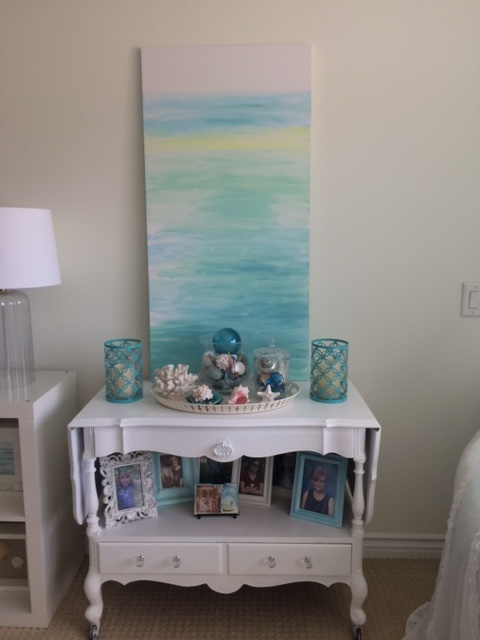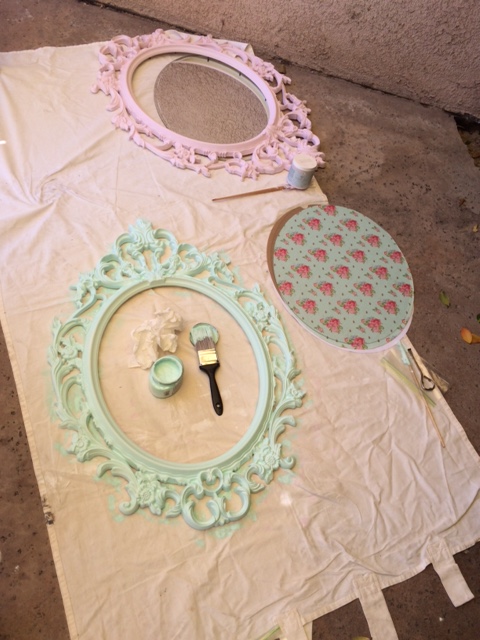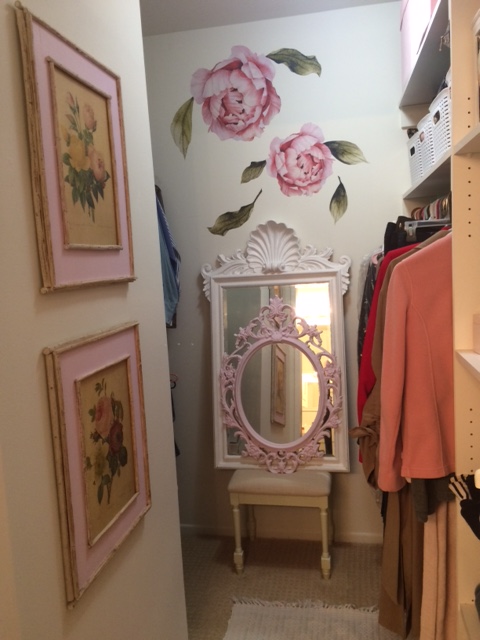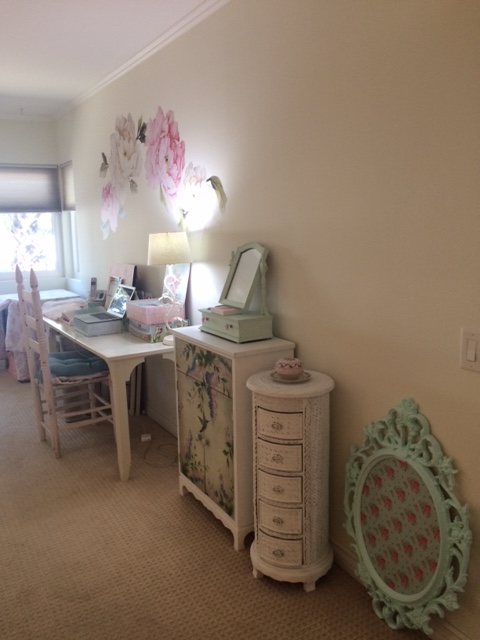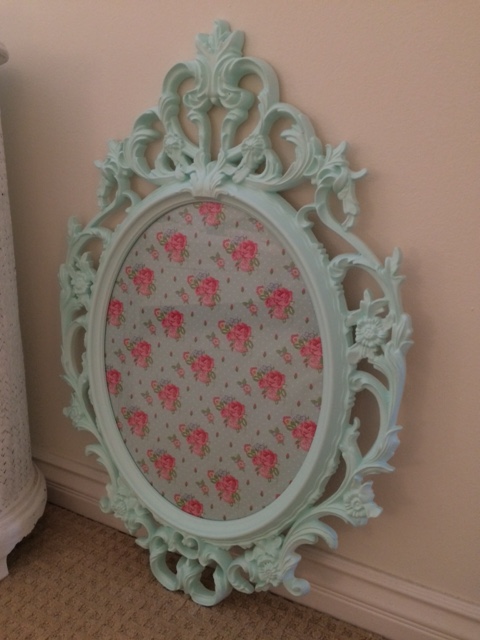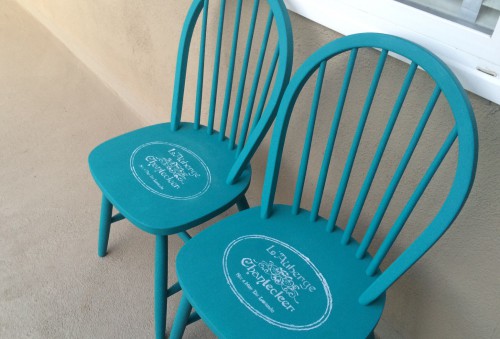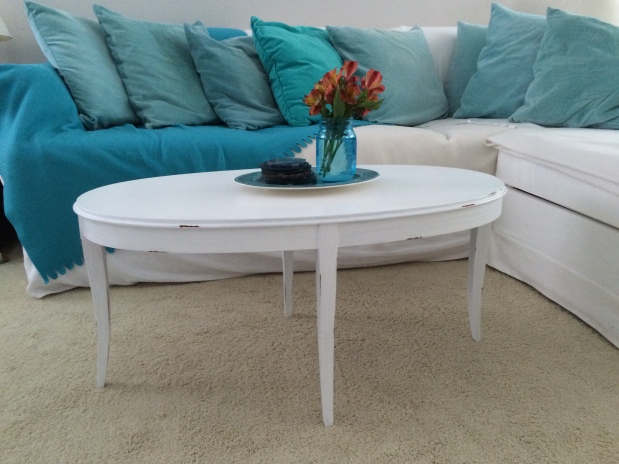Sometimes a project just kicks your butt. Such was the case with my recent DIY French country dining chairs using that hot trend: chalk paint. Why does no one tell you that chalk paint rubs off? Now, I know that most DIYers use a product called Annie Sloan Chalk Paint, which probably doesn’t rub off. I’ve heard her paints work great for refinishing furniture in the shabby chic and French country styles, among others. Well, I couldn’t find any Annie Sloan paints at my local Michael’s crafts store, so I went with something else.

I “recycled” these 2 cottage chairs from a dumpster. Cost? Zero dollars.
That “something else” was sitting on a shelf in the unfinished wood project aisle at Michael’s. There were actually two different chalk paint product lines available there. The first was by Americana Decor, which offers a selection of “Chalky Finish” paints in faded pastels, as well as “Creme Wax” and “Soft-Touch Varnish” as two options for sealants. This company also offers a great line of French Country stencils, to add that touch of Provence to your DIY French-inspired projects.

Americana Chalky Finish paint products
Since I was going for a French Country look, I nabbed an adorable French Inn stencil, with the intention of stenciling the motif onto the seat of each dining chair. While I was at it, I also nabbed one bottle each of Americana Decor’s Creme Wax and Soft-Touch Varnish, just in case I needed to seal my roughed-up edges (I’m so thankful I did, but more about that later.)
The second paint product on the shelf was spray on Krylon Chalky Finish Paint. I’ve used Krylon spray paints before for my smaller decorating projects, and they have worked great. I had no idea they were now offering Chalky Finish paints!

Spray on Krylon Chalky Finish Paint
I spotted a can in “Tidal Blue,” a beautiful shade of teal, and one of my favorite colors. That hue would be perfect for these cottage-style chairs, and would add a nice pop of color to the dining area of my aquamarine-accented “shabby beach” apartment in coastal California.
Another bonus: cottage chairs can be time-consuming to paint, so spray painting can be a real time-saver. Theoretically.

Prepping the chairs required some elbow grease: scraping, cleaning and light sanding.
Time to clean up the chairs.
I found these two shabby “chaises” in a dumpster last Sunday (yes, I’m all about recycling and upcycling, and I’m not ashamed to confess to some dumpster diving in my hunt for shabby chic furniture and other treasures), so they were pretty grubby.
I scraped off old dried paint globs, scrubbed the chairs down with dish soap to remove the soot and grime, and gave them a very light sanding with a sanding block of fine sandpaper.

Spray painting the chairs was messy and smelly…and required 2 cans of paint.
After prepping a work area behind my building with a large drop cloth, I donned my paint scrubs, put on a specially-ventilated face mask (spray painting can get messy, and it smells noxious), and got down to business. I sprayed using short, even spurts, just as instructed by the experts on HGTV.
In no time flat, I had used up my entire can of “Tidal Blue” paint, and it only covered one chair and one-third of the second chair. I headed back to Michael’s for another can of paint. More than an hour later, both chairs were covered with a good coat of paint, and I took a breather. Man, those face masks are hot and that spray on stuff smells bad!
I let the chairs dry for a little over an hour, making sure they were dry to the touch before I handled them. I carried them back to my patio, and looked down to find that my arms and hands were covered with teal chalk. Lesson learned: chalky spray paint is…chalky.

A French Country stencil for the seat of each chair.
I forged ahead with stenciling the chair seats, figuring I could worry about sealing the chalk paint later. For my stenciling I decided to use white gesso, which is the paint base that artists use to paint their canvases pure white. Gesso works well as a whitewash on unfinished wood, and I’d been wanting to try it as a stenciling medium. Bad idea.

Stenciling with gesso…not recommended.
Even after I dabbed off the excess paint on a rag, the gesso was far too runny to serve as a good stenciling medium. I persevered, figuring I could worry about tidying up any really messy edges later. From a distance, the chairs were looking beautiful, but this project was not going as smoothly as I’d anticipated.

What a mess!
Should I repaint the seats of the chairs and start over with the stencils? I switched my focus to sanding the edges of the chairs to give them a slightly battered, French Country look. My hands and sanding block were soon covered in teal chalk. What a mess!

Taking a break with a cup of caffe mocha at The Yellow Vase in Palos Verdes, CA.
I decided to take a break. A nice walk along the beach and a cup of java are always a good combination for alleviating frustration and coming up with new solutions! A little chocolate never hurts, either, so I headed out to one of my favorite Parisian-style cafes, The Yellow Vase in Palos Verdes, and ordered an extra large caffe mocha.
Sufficiently caffeinated and re-inspired, I returned home to tackle the “chair problem.” Those sloppy stencils didn’t look so bad after all, especially without my glasses on. The messy paint kind of gave the lettering softened edges, lending them an aged look. I was actually going for an old-world village cafe look, so I left the stencils as they were.

Applying a coat of Soft-Touch Varnish to seal the chalk paint.
I had two options for sealing the chalk paint: a spray on “Wax Coating” from Krylon or the small bottle of varnish from Americana Decor. I didn’t think I could face another spray painting session, so I opened up the bottle of Soft-Touch Varnish from Americana Decor.
The label on the back promised the varnish was low odor, scratch and rub resistant, easy to apply with a brush, and would seal any chalk paint or acrylic paint.

The varnish looked milky when wet, but dried clear.
The label on this product was true to its word. The varnish brushed on a bit thick and milky-colored, but dried beautifully–clear and virtually invisible.
This handy varnish left the chalk paint completely sealed, and retained a matte finish.

Two DIY French Country dining chairs, dried, sealed and delivered.
I let the varnish dry for the recommended two hours, and then ran a white paper towel over every nook and cranny on each chair. No more “teal chalk” rub off. The chairs were sealed.
Voila! The road to completion was a bit long and bumpy, but I now have two DIY French Country chairs with a touch of coastal chic. Mission accomplie!
My recommendation for anyone who wants to try this: definitely plan on sealing any furniture you refinish with spray on chalk paint. And, be sure to perform a “white glove” test when you’re done and the paint has dried to make sure the paint doesn’t come off on you, or your guests.
I’d like to find two more dining chairs to match or complement these ones, and I’ll try chalk painting again, but will most likely try the brush-on kind next time. I’m more prepared after this experience, and also now that I’ve read this helpful how-to blog post on “How to Paint a Chair with Chalk Paint” from Anne over at White Lace Cottage.
I’m open to suggestions from other furniture DIYers who’ve had success with chalk paints, so feel free to leave a comment with any tips or techniques you’d like to share!
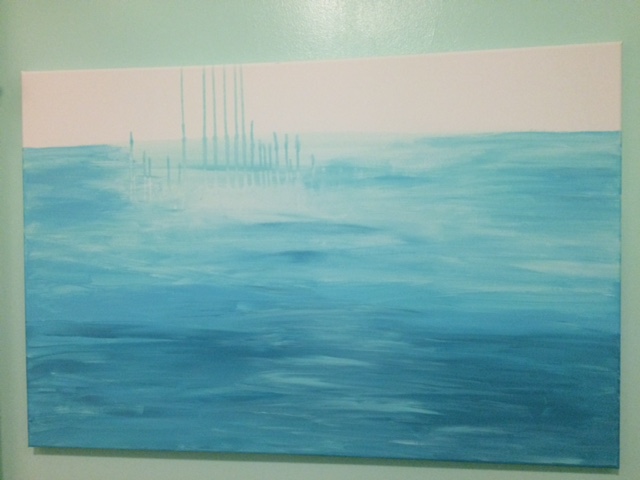 Whenever I am feeling low or anxious, my go-to for relieving stress and sparking joy is painting. If I can paint a picture or even a picture frame or a piece of furniture, brushing a beautiful color onto just about any surface relaxes me. When I am painting, I try to focus more on the process than on the end result. I think more about how the colors blend together, where I need to add more pigment to intensify the shade, or more water for a lighter wash of tint. In my case, the colors of choice are varied shades of aqua or pink. Aqua is so peaceful and soothing to my eyes and sensibilities. Pink just makes me happy!
Whenever I am feeling low or anxious, my go-to for relieving stress and sparking joy is painting. If I can paint a picture or even a picture frame or a piece of furniture, brushing a beautiful color onto just about any surface relaxes me. When I am painting, I try to focus more on the process than on the end result. I think more about how the colors blend together, where I need to add more pigment to intensify the shade, or more water for a lighter wash of tint. In my case, the colors of choice are varied shades of aqua or pink. Aqua is so peaceful and soothing to my eyes and sensibilities. Pink just makes me happy!